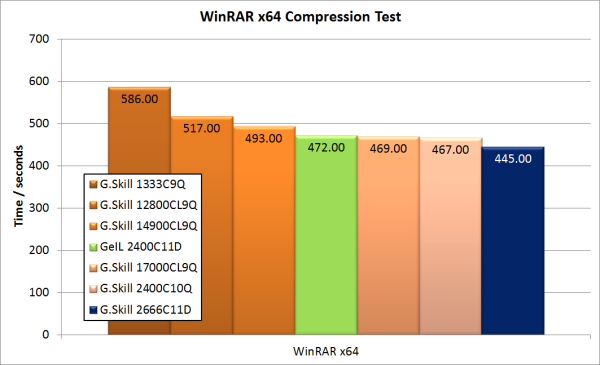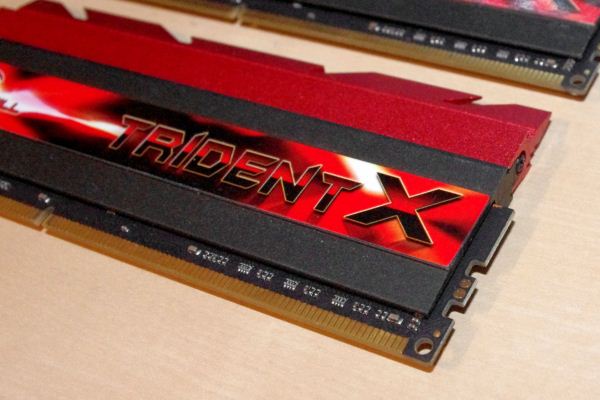G.Skill TridentX Review: 2x4GB at DDR3-2666 C11-13-13 1.65V
by Ian Cutress on October 28, 2012 12:00 PM ESTConclusions
Trying to argue the case for a 2x4 GB DDR3-2666 C11 kit for $170 is a monumental task. 4x4 GB kits of 2400 C10 offer double the capacity at a similar price point with no real change in real-life performance. Arguably neither does 4x4 GB 2133 C9 which is even cheaper, or 2x8 GB 2400 C11 which offers the same amount of modules but double the density.
From our benchmarking results, the 2666 C11 was predicted by MemTweakIt to come out on top, and in all the benchmarks we have that show results, it did, often by the smallest margins. The biggest difference seems to be with respect to WinRAR, where for our 450+ second test the 2666 C11 kit performed 22 seconds faster than a 2400 C10 kit. If that 5% change can be justified in the price for what you do, then this kit could be for you.
The only other placement for this kit is really in the hands of extreme overclockers. I am a competitive overclocker – it is one of my hobbies that I find fascinating, even if it is only trying to get a number on a screen higher than the next guy. But overclocking is like drag racing for computers – there are very few people in the market to purchase these kits compared to the majority of users that need memory. As a kit for overclockers, it works quite well, hitting 2800 C11 without a bump in voltage, and I was able to boost this to 2950 C11 with a bump in voltage. No doubt with some more knowledge and tweaking this could break the 3000 MHz barrier.
The immediate future for memory still lies in DDR3 – the next iteration, DDR4, is still several years away. We are told that on the Intel side of things, Haswell is DDR3, as will be Broadwell, the Haswell replacement. Reports expect DDR4 to be less than 10% of the market in late 2014 (early adoption in the high end space), but 50%+ across 2015. DDR4 is expected to have a base speed of 2133 MHz up to 3200 MHz for initial enthusiast applications – though given the rise in enthusiast speeds this could seemingly be pushed to 4266 MHz+ over the course of the development cycle. DDR4 is also expected to be a single module per channel, paving the way for up-to-quad channel in the mainstream arena.
But for now, if synthetics matter, then the 2x4 GB F3-2666C11D-8GTXD 2666 C11 TridentX kit offers some overclocking headroom. All other increases (at XMP) are marginal at best from previous kits. Kits like this will become more commonplace when processors adjust the tested IMC rated speed – the high end Trinity processors are rated at 1866 MHz minimum, so it only needs to raise another 1000 MHz or so. This should hold true in 2015 when DDR4 is part of the desktop hierarchy.
If you are on the lookout for a 2x4 GB memory kit, as of 10/18, here is what Newegg looked like:
| 2x4 GB Memory Kits | ||||||||
| 1600 | 1866 | 2000 | 2133 | 2400 | 2600 | 2666 | 2800 | |
| CL 7 |
$73 Corsair $70 G.Skill $70 Mushkin $65 Mushkin |
|||||||
| CL 8 |
$60 Crucial $55 Corsair $55 G.Skill $55 Crucial $55 Mushkin $53 G.Skill $53 Crucial $52 Mushkin $52 Corsair |
$75 G.Skill | ||||||
| CL 9 |
$86 Corsair $48 G.Skill** $47 Kingston $47 Corsair** $46 Avexir $45 G.Skill** $45 Kingston $45 Avexir** $44 Patriot** $43 Kingston** $42 Corsair $42 ADATA $42 Kingston $42 Mushkin** $41 Corsair $41 Kingston $41 Patriot and below |
$90 Corsair $75 Corsair $60 Mushkin $60 Avexir $55 G.Skill $55 Kingston $55 Crucial $55 Mushkin $53 Crucial $53 Kingston $52 Corsair $52 PNY $50 Corsair $50 G.Skill $50 Kingston $50 Patriot $50 Crucial $50 Team $49 Corsair $49 G.Skill $48 GeIL $47 Patriot $46 Kingston $44 Corsair |
$75 Corsair $68 Mushkin $65 Avexir $60 Corsair $60 Mushkin |
$130 Corsair $120 Corsair $110 Corsair $70 Corsair $70 Avexir $65 Mushkin $64 G.Skill $62 Team $61 G.Skill $60 G.Skill $60 Mushkin |
||||
| CL 10 |
$85 PNY $60 Mushkin $56 Team |
$100 Avexir $85 Mushkin $82 Team $77 Corsair $75 G.Skill $72 G.Skill $70 G.Skill |
$168 Team $165 G.Skill |
|||||
| CL 11 | $45 Samsung | $49 Kingston* |
$58 Corsair $57 Patriot $56 Corsair $55 Team $50 G.Skill $50 Kingston $50 Patriot $50 Team $50 GeIL |
$103 G.Skill $95 Team $77 Patriot $75 GeIL $60 Kingston |
$180 Kingston $170 G.Skill $160 Corsair $160 Avexir |
$600 G.Skill | ||
| CL 12 | $270 Avexir | |||||||
|
* Plug and Play ** Low Voltage |
||||||||
Please note this table does not take into account warranty or any 'extras' or sub-timings that may come from each kit.












28 Comments
View All Comments
Samus - Sunday, October 28, 2012 - link
ditto, they're ridiculous. older g.skill memory (2008-2011) had a clean, effective design, this is pretty childish.primonatron - Sunday, October 28, 2012 - link
Why keep posting photos of RAM with heat spreaders not fitting on the mini-ITX board in reviews? The board is obviously not designed to accomodate them, and to keep posting the pictures just looks like the reviewer is stupid and hasn't learnt that yet. It even says under the photos the review is on an ASUS P8Z77-V Premium. A proper full size ATX, is what the companies would expect buyers to be using.just4U - Sunday, October 28, 2012 - link
It gives the user an idea (perhaps?) of how it will fit in their own setup if their using a large cooler. It sort of does need to be mentioned (almost as a disclaimer) for any buyers looking at ram when their system is in need of something with heatsinks of a lower profile.JeauxBleaux - Sunday, October 28, 2012 - link
and both have wasted vast amounts of page space and my time showing memory stick profiles that won't fit on a motherboard that was never intended to carry those sticks in the first place. Memory sticks may or may not have a tall profile due to their heatsink(s) but may also have fan kits mounted on them in the absence of huge heatsinks.What is the point of that? The author's choice of motherboard and massive cooling tower obviously preclude the use of most high performance memory w/heatsinks and/or fan kits and would certainly lead me to believe that the author has little experience in thoughtfully putting together a "system" in which all components play well together.
So, while I appreciate the benchmarks the author displays and the consideration that has gone in to the testing of these memory sticks, a more appropriate representation of the ill fit of these particular memory sticks would be a simple one-liner and maybe ONE picture of what NOT to try to mount them in. Because, seriously, it makes the author look like he/she is simply trying to make the maufacturer look and only succeeding in making himself/herself look ignorant.
just4U - Sunday, October 28, 2012 - link
It doesn't matter if it was meant for a low end setup or now.. there are alot of higher end boards that won't allow for that clearance either when paired with certain coolers.bunnyfubbles - Sunday, October 28, 2012 - link
part me wishes that faster memory could actually make a difference in real world performance, the other part is thankful I need no more than the low profile Samsung 30nm green stuff :)GhostClocking3 - Monday, October 29, 2012 - link
If you're willing to spend the money for better RAM you should easily be able to afford to go water to make it fit. That ultimately led me to have to switch since air cooler had to get larger to to cool more effectively.I don't blame anandtech for showing the RAM fitting, that is probably the most frequently asked question ever. Does it fit, blah, blah, blah.
Tchamber - Monday, October 29, 2012 - link
So if so many of these kits have clearance issues, and don't generate a lot of heat, why are the spreaders so tall? So they can charge more? Or do the aesthetics really sell?Guspaz - Monday, October 29, 2012 - link
This review (and the one that preceded it) really just go to illustrate how pointless all this is. Clockspeed, latency, the differences in these don't translate to any significant difference in real-world performance. There's not much point, it would seem, in buying anything beyond something cheap and reliable (KVR if you don't want heatsinks, basic HyperX if you do). Any extra money spent on top of that would have been far better spent on a faster CPU.So, if you've got 16GB of RAM, you can pay $70 for KVR, or $80 for HyperX... Or you can pay $340 for the RAM reviewed here
And you know what? There's no real performance difference in real-world applications. Oh, sure, you see a percentage point or two here and there, but you know what will give you a much bigger boost for your extra $260? Getting a faster CPU or GPU. Those will make a FAR bigger difference than the RAM.
Guspaz - Monday, October 29, 2012 - link
I think the point of my comment above is "Please stop reviewing useless memory kits and review something that actually matters."Reviewing these things is a waste of everybody's time, both yours and ours.